#pre-Columbian
Explore tagged Tumblr posts
Text
500-year-old Snake Figure from Peru (Incan Empire), c. 1450-1532 CE: this fiber craft snake was made from cotton and camelid hair, and it has a total length of 86.4cm (about 34in)
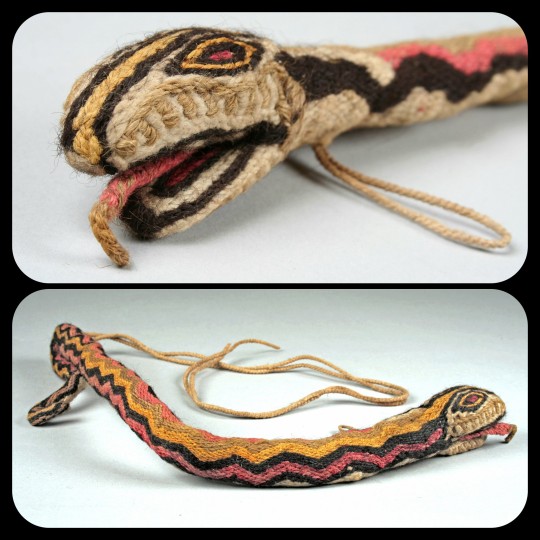
This piece was crafted by shaping a cotton core into the basic form of a snake and then wrapping it in structural cords. Colorful threads were then used to create the surface pattern, producing a zig-zag design that covers most of the snake's body. Some of its facial features were also decorated with embroidery.
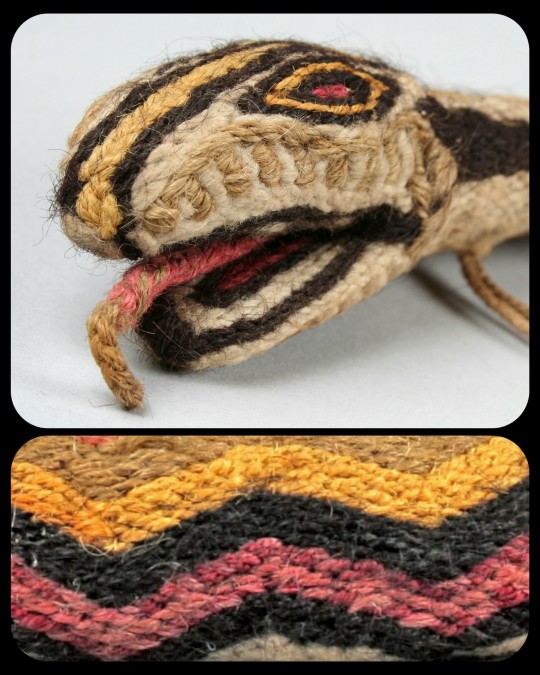
A double-braided rope is attached to the distal end of the snake's body, near the tip of its tail, and another rope is attached along the ventral side, where it forms a small loop just behind the snake's lower jaw. Similar features have been found in other serpentine figures from the same region/time period, suggesting that these objects may have been designed for a common purpose.
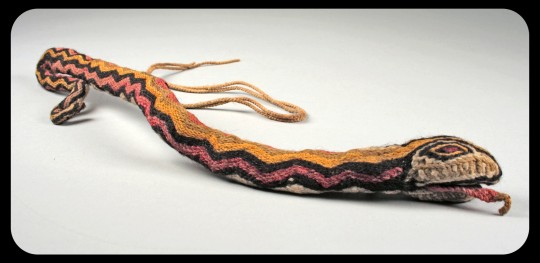
Very little is known about the original function and significance of these artifacts; they may have been created as decorative elements, costume elements, ceremonial props, toys, gifts, grave goods, or simply as pieces of artwork.
The Metropolitan Museum of Art argues that this figure might have been used as a prop during a particular Andean tradition:
In a ritual combat known as ayllar, snakes made of wool were used as projectiles. This effigy snake may have been worn around the neck—a powerful personal adornment of the paramount Inca and his allies—until it was needed as a weapon. The wearer would then grab the cord, swing the snake, and hurl it in the direction of the opponent. The heavy head would propel the figure forward. The simultaneous release of many would produce a scenario of “flying snakes” thrown at enemies.
The same custom is described in an account from a Spanish chronicler named Cristóbal de Albornoz, who referred to the tradition as "the game of the ayllus and the Amaru" ("El juego de los ayllus y el Amaru").
The image below depicts a very similar artifact from the same region/time period.
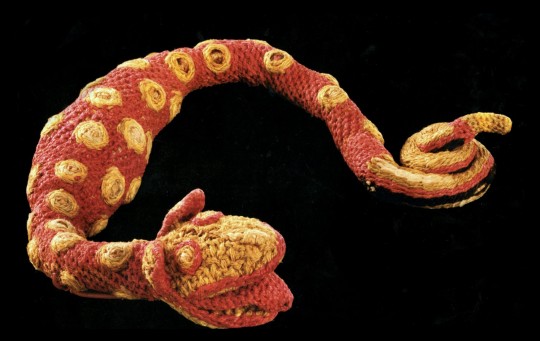
Why Indigenous Artifacts Should be Returned to Indigenous Communities.
Sources & More Info:
Metropolitan Museum of Art: Snake Ornament
Serpent Symbology: Representations of Snakes in Art
Journal de la Société des Américanistes: El Juego de los ayllus y el Amaru
Yale University Art Gallery: Votive Fiber Sculpture of an Anaconda
#artifacts#archaeology#inca#peru#anthropology#fiber crafts#americas#pre-columbian#andes#south america#art#snake#effigy#textiles#textile art#embroidery#history#stem stitch#serpent#amaru#mythology#andean lore#fiber art#incan empire#indigenous art#repatriation#middle ages#flying snakes tho
923 notes
·
View notes
Photo
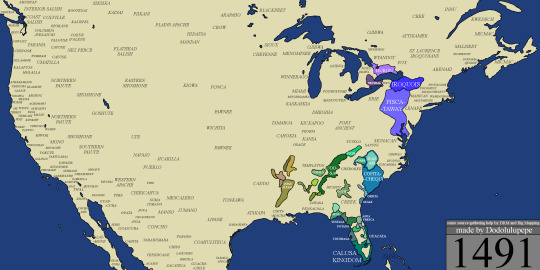
The continental United States in 1491, the year before Columbus' arrival, showing both tribal units and centralized states.
421 notes
·
View notes
Text

Basalt sculpture of the Taino people of the Caribbean, representing a zemi (deity or another supernatural being), perhaps Maquetaurie Guayaba, lord of the Land of the Dead. Artist unknown; between 800 and 1500. Now in the Walters Art Museum, Baltimore. Photo credit: Walters Art Museum.
#Indigenous Peoples Day#art#art history#indigenous peoples#indigenous art#Taino#Caribbean art#Taino art#Pre-Columbian#sculpture#stonework#basalt#indigenous religions#Walters Art Museum
289 notes
·
View notes
Text
Mayan ruin, Copan, Honduras

64 notes
·
View notes
Text
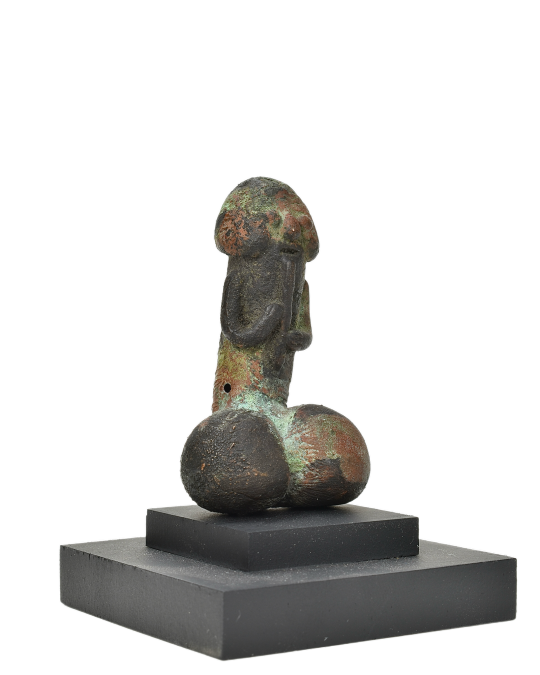
Erect Phallic imagery was crucial in Moche’s art and symbolism, carrying deep cultural and religious significance. Integrating a human flutist element within the phallus conveys multiple layers of meaning. The flute is often associated with fertility and agricultural rituals, suggesting its use in ceremonies intended to invoke prosperity and divine favor. The depiction underscores the Moche’s sophisticated understanding of the interconnectedness of music, fertility, and spiritual well-being. Music, an integral part of Moche ceremonies, was believed to enhance ritual potency and communicate with the divine. The stature of an erect penis and large testicles further emphasize fertility and potency, making this artifact a powerful symbol within Moche cultural and religious practices.
#ancient art#ancient history#archaeology#pre-columbian#art history#artifacts#inca#aztec#mayan#south america#moche#musician#flutist#erect penis#phallus
28 notes
·
View notes
Text




9 notes
·
View notes
Text
For the people of ancient Colombia, gold had no monetary value, but rather spiritual and transformative powers. It was not only offered to the gods, but – together with the use of music, hallucinogens and dancing – also helped those who wore it to engage with the spirit world. With the use of bodily adornment and animal iconography, spiritual leaders believed they could take on the characteristics of a range creatures, including bats, jaguars and crocodiles, all thought to have the ability to cross liminal boundaries.
— Emily Spicer, "Beyond El Dorado: Power and Gold in Ancient Colombia."
Follow Diary of a Philosopher for more quotes!
#El Dorado#The Legend of El Dorado#Quote#quotes#British Museum#Pre-Columbian#pre columbian#artwork#gold#shamanism#academia#studyblr#gradblr#I've read elsewhere that it did have monetary value so for me that first line is a little confusing
10 notes
·
View notes
Photo

‘Chimú Funerary Attire’, Imperial Epoch (1300 AD-1532 AD), at the Museo Larco in Lima, Peru
These gold adornments once belonged to a major leader of the mud brick city known as Chan Chan, the capital of the Chimú Empire. The feathers on the crown, breastplate and epaulettes express the relationship between birds and the sun, in the celestial world.
#chimu#moche#inca#peru#pre-columbian#south america#gold#jewelry#andean#atlantis#indigenous people#american indians
131 notes
·
View notes
Photo
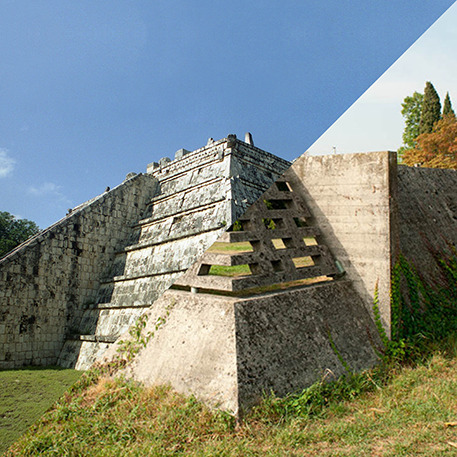
Osario | High Priest's Temple, Chichén Itzá, Mexico, 750-900 AD VS Carlo Scarpa, Tomba Brion, Cimitero di San Vito, Altivole, Italy, 1974-1978
#osario#temple#Chichén Itzá#mexico#Maya#yucatan#Maya sites#archaeology#america#Archaeoastronomy#Pre-Columbian#carlo scarpa#tomba brion#brion cemetery#concrete#italy#italia#Altivole
81 notes
·
View notes
Text

Maya Invading Visigothic Spain
It is the 500s AD in an alternate timeline, and a Maya army has rowed on the Gulf Stream across the Atlantic Ocean to the Iberian peninsula (modern Spain and Portugal). Their agenda is to “liberate” the local Hispano-Roman population from their Germanic Visigothic rulers…and maybe obtain some captives for sacrificial rituals in the process.
The Visigoths might possess iron weapons, armor, and horses, but the Maya like other Mesoamerican soldiers have at their disposal spears, darts, and clubs edged with obsidian that can have an even sharper cutting edge than steel!
#alternate history#maya#mayan#mesoamerican#native american#pre-columbian#visigoths#spain#european#digital art#illustration#art
3 notes
·
View notes
Text
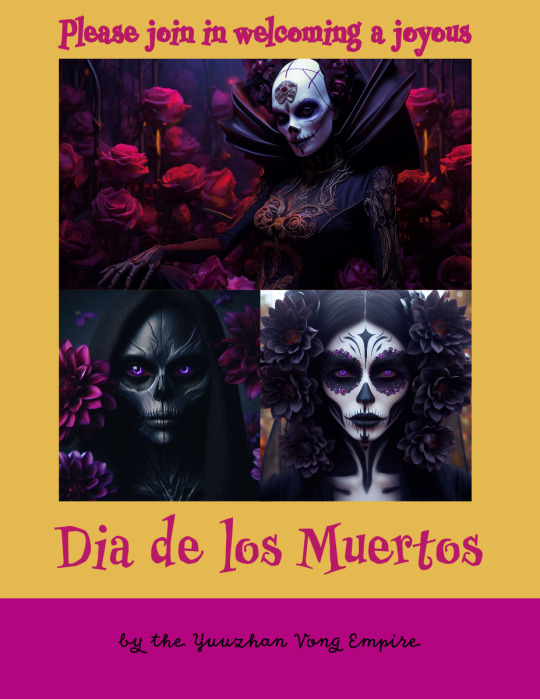


SWAG77 celebrates Dia de los Muertos (Day of the Dead) by featuring the Star Wars Yuuzhan Vong or the Grysks, known as the Yuuzhan Vong Lite. Check out their true appearance, unique humanoid masquers and elaborate celebratory Dia de Muertos costumes! The Yuuzhan Vong honor their dead with great appreciation in celebration to travel across the rainbow bridge onto the next life. Dying is a natural part of life and based on their Gods. In real life, the Yuuzhan Vong are based off the Aztec and Mayan Pre-Columbia Meso-American and South American cultures. Unsure Disney Lucasfilm will keep that attribute of them since they are villains. But we will keep it. The top image is a high priestess The middle image is a warrior
The last image is a bureaucrat-administrator.
#star wars#yuuzhan vong#grysks#dia de los muertos#day of the dead#dia de muertos#pre-columbian#meso-american#south american#aztec#mayan#disney#lucasfilm
6 notes
·
View notes
Text
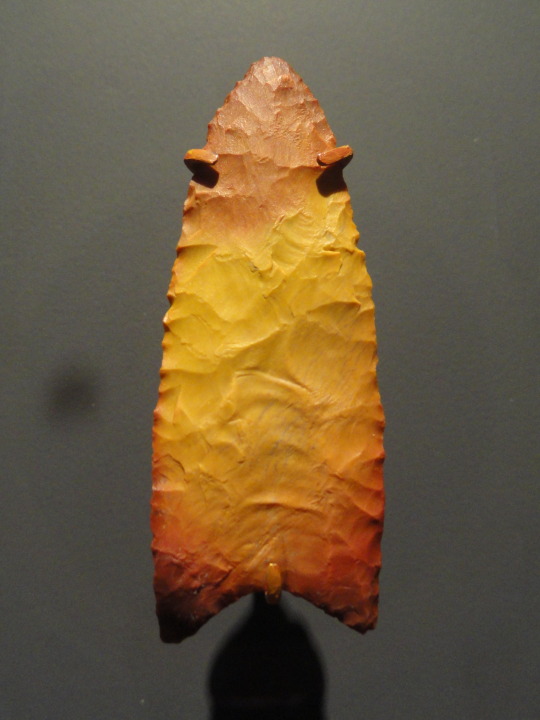
Clovis point, fashioned from chert and belonging to the Clovis culture (so named from early 20th century archaeological finds near Clovis, New Mexico) that spread throughout North America following the Last Glacial Period. Clovis points are distinguished by manufacture through the pressure flaking technique and by fluting near the base. Manufactured between 11,500 and 9,000 BCE and found in Sevier County, Utah; now in the Natural History Museum of Utah, Salt Lake City.
#prehistory#prehistoric#Pre-Columbian#Paleoamerican#Paleoindian#Clovis#Clovis culture#Clovis point#ancient weapons#archaeology#artifact#spearpoint#Natural History Museum of Utah#Stone Age
346 notes
·
View notes
Text
Quite a difference in age between the temple remains and the human burials. I firmly believe that sacred sites often remain sacred, even after the passage of millennia.
21 notes
·
View notes
Text

Pre-Columbian civilizations across the Americas developed various adhesives used in everyday applications and ceremonial contexts. These adhesives were crafted from natural materials, such as plant resins, tree gums, and animal-based glues, with their use spanning numerous cultural groups, including the Maya, Aztec, Inca, and Moche. By understanding the properties of their surrounding environment, these cultures could create adhesives suitable for tool-making, repairing objects, crafting jewelry, and producing artwork.
This article will focus on the adhesives used by these ancient cultures, how they were made, and the specific applications seen in archaeological findings.
Moche Wood Scepter c. 400-800 AD. closeup view
Moche wood scepter w/ inlaid Shell and Stones
Materials Used in Pre-Columbian Adhesives
Pre-Columbian adhesives were primarily sourced from plant resins, tree gums, and animal derivatives. Each civilization developed unique techniques to harvest and process these natural materials to suit their environmental and cultural needs.
Plant Resins and Tree Gums
Plant resin was one of pre-Columbian cultures’ most widely used adhesive materials. Resins such as copal, commonly used by the Maya and other Mesoamerican civilizations, were derived from trees in the Burseraceae family. The Maya used copal resin for both ritual and practical purposes. It was often burned as incense in religious ceremonies, but in a solid form, it was an adhesive for binding materials such as stone and wood.
The Aztecs also exploited natural resins, particularly pine resin. Pine resin was commonly mixed with natural powders like ash or powdered stone to enhance its adhesive properties. This combination was often applied to tools, pottery repairs, or affixing feathers and stones to wooden or clay artifacts.
Animal-Based Adhesives
In some pre-Columbian cultures, animal-based adhesives were also used, although these were less documented than plant resins. These adhesives were typically made by boiling animal hides, bones, or tendons to produce gelatinous substances that, when cooled, formed a strong bond. Andean civilizations, such as the Inca, likely employed these adhesives, though less direct evidence survives than their Mesoamerican counterparts.
For example, animal-based glues may have been used in textile production to attach decorative elements such as feathers to ceremonial garments or headpieces. However, animal-based adhesives’ exact prevalence and variety are not as well-documented as resin-based adhesives.
Methods of Production and Application
The production of adhesives in the pre-Columbian Americas required an understanding of local materials and their properties. Though methods varied between cultures, specific techniques were standard across regions.
Resin Extraction and Processing
Plant resins like copal were often harvested by cutting into the bark of resin-producing trees. The resin would ooze out and harden upon exposure to air, after which it could be collected and stored. When needed, the hardened resin was heated over a fire or other heat source until it became a thick liquid. Once liquefied, it could be applied to objects as an adhesive.
For specific applications, additives like powdered stone or pigments were mixed into the resin to adjust its texture or increase its durability. For example, this practice was common in affixing decorative stones to jewelry or securing blade heads to wooden shafts for tools and weapons.
Paracas Wood, Stone and Feather Club for Sale
Paracas wooden club w/inlaid Stone
Application Techniques
Adhesives were applied directly to the surfaces that needed bonding, often in thin layers. When used to repair pottery, artisans would apply the glue to the broken edges and carefully press the pieces together, holding them in place until the resin hardened. In some cases, additional adhesive was applied over the joints to reinforce the bond.
For weaponry and tools, adhesives were often used with other fastening techniques. For example, in Mesoamerican cultures, resin might have been used to help secure stone blades to wooden handles, followed by wrapping the joint with plant fibers for additional strength.
Cultural Examples of Adhesive Use
Several archaeological findings highlight the importance of adhesives in pre-Columbian material culture. Below are examples of how various civilizations across the Americas used adhesives.
Maya Copal Resin
The Maya extensively used copal resin for ceremonial incense and as an adhesive for repairing ceramics and affixing small decorative stones or shells to larger objects. For instance, archaeologists have found examples of jade and shell inlays on wooden objects in Maya tombs held in place by hardened copal resin.
Aztec Featherwork
Featherwork, a vital art form in Aztec and Maya civilizations, required adhesives to attach vibrant bird feathers to textiles, shields, and headdresses. In Aztec society, feather artisans, known as amantecas, used a combination of plant-based resins, such as pine resin, to bind the feathers in place. The featherwork pieces served decorative and religious purposes, demonstrating the adhesive’s role in crafting items of cultural significance.
Inca Wood and Stone Artifacts
In the Andean regions, particularly within the Inca Empire, adhesives were employed in various woodworking and stone-carving techniques. For example, adhesives were used to fasten metal or stone inlays into wooden objects, such as ceremonial staffs or chicha cups. Additionally, using resin-based adhesives for pottery repair has been suggested by analyzing broken and mended artifacts found in Inca archaeological sites.
Moche Metalworking
The Moche civilization of northern Peru is known for its advanced metallurgy and intricate artwork. Moche artisans likely used plant-based adhesives in their fine metalworking to affix precious stones or inlays into metal pieces. Some surviving Moche metal objects, such as ornamental plaques and jewelry, show evidence of adhered stone inlays using organic adhesives.
Moche Pututu Trumpet Shell Horn front side view
Moche Pututu Shell – Waylla Kepa w/ inlaid Silver Mouth Piece
Wari Mask Product for Sale
Wari False Head w/inlaid Shells
Conclusion
Pre-Columbian adhesives played a crucial role in the daily and ceremonial lives of the Maya, Aztecs, Inca, and other ancient civilizations. By utilizing plant resins like copal and pine and possibly animal-derived glues, these cultures produced durable and versatile adhesives for repairing ceramics, crafting tools, and creating intricate works of art. The widespread use of these adhesives, as demonstrated by surviving artifacts, provides insight into the technological sophistication of these pre-Columbian societies. Their understanding of natural resources allowed them to create functional and integral materials for their cultural and artistic practices, ensuring that these innovations would endure through the ages.
How to Determine Cotton Fabric from Camelid Fibers Accurately?
Research Academic Papers and News Articles
#ancient art#ancient history#archaeology#pre-columbian#art history#artifacts#inca#aztec#mayan#south america#ancient technology
9 notes
·
View notes
Text

American Holocaust — David E. Stannard
#i think about (and other stories like this) a lot#pre-columbian#child rearing#codes of friendship#aztec#mexican#iroquois#indians of california#hospitality#cartier#1500s#american holocaust#American Holocaust: The Conquest of the New World#holocaust#David E. Stannard#history#nonfiction#spanish#north america#south america#native#indigenous#mexico#atypicalreads#nsnv#cw genocide#cw violence#colonialism#central america
2 notes
·
View notes
